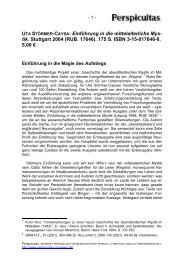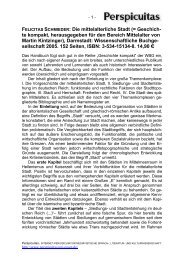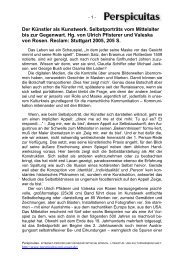Inventing Norman Cantor: Confessions of a Medievalist. By Norman ...
Inventing Norman Cantor: Confessions of a Medievalist. By Norman ...
Inventing Norman Cantor: Confessions of a Medievalist. By Norman ...
Create successful ePaper yourself
Turn your PDF publications into a flip-book with our unique Google optimized e-Paper software.
1<strong>Inventing</strong> <strong>Norman</strong> <strong>Cantor</strong>: <strong>Confessions</strong> <strong>of</strong> a <strong>Medievalist</strong>. <strong>By</strong> <strong>Norman</strong>F. <strong>Cantor</strong>. Arizona Center for Medieval and Renaissance StudiesOccasional Publications 1. Tempe, Arizona: Arizona Center forMedieval and Renaissance Studies, 2002. Pp. 256. $28.95/£24.00.ISBN 0-86698-293-0.As a teaching assistant at Princeton in the early 1950s, <strong>Norman</strong> <strong>Cantor</strong> wasasked to lecture on St. Augustine for an undergraduate humanities survey. “Ifocused on Augustine’s powerful sex drive,” he tells us, “and, as a native NorthAfrican, his contempt for Rome, and his authoritarian belief in the use <strong>of</strong> violenceagainst heretical Christian minorities” (27). The course’s appointed pr<strong>of</strong>essors, thehead <strong>of</strong> the Religion Department and “a classical philosopher <strong>of</strong> standing” (26),were not amused, and the young <strong>Cantor</strong> was not invited back.The incident forms something <strong>of</strong> a paradigm for <strong>Cantor</strong>’s posturethroughout a manifestly turbulent career: anti-authoritarian, ethnically selfconscious,stubbornly asserting the reality <strong>of</strong> the passions, and just a little eager tonoodge the Establishment. In this memoir <strong>of</strong> a pr<strong>of</strong>essional trajectory spanning arange <strong>of</strong> institutions—Princeton, Columbia, Binghamton, Brandeis, Barnard,NYU, and the University <strong>of</strong> Illinois at Chicago, along with a Fulbright stint at TelAviv—<strong>Cantor</strong> portrays himself as a chronically self-divided outsider, strugglingfor acceptance yet willfully impolitic, deeply attracted to the academy yet keenlyattuned to its pretension, venality, and doublespeak. Son <strong>of</strong> a Russian Jewimprobably reborn as a Manitoba cattle rancher, <strong>Cantor</strong> grew up suffocated, as hedescribes it, by “the smell <strong>of</strong> manure and dust” (1) and looked to escape throughscholastic achievement. But he soon came up against a similarly noxious cloud <strong>of</strong>anti-Semitism, losing out on prizes because, as his principal put it, “the college’sBoard <strong>of</strong> Trustees are on my back” (6) and advised to pursue graduate studyoutside Canada because, in the words <strong>of</strong> a “canny Scottish” mentor, “they don’tlike Jews in this country” (7). Despite earning a fellowship, <strong>Cantor</strong> found himselfsocially marginalized at Princeton as well because he was sartorially challenged(“You won’t be around here long, <strong>Cantor</strong>, unless you get some Ivy Leagueclothes” [33]) and didn’t play poker; “vestigial anti-Semitism” (57) repeatedlyblocked his pr<strong>of</strong>essional advancement. It should be recognized, <strong>of</strong> course, that<strong>Cantor</strong> himself falls into recurrent self-caricature as traditional schlemiel andschlimazl, folkloric archetypes surely familiar from his early immersion in Yiddishculture (12-13); he mocks, for example, his rejection by one <strong>of</strong> the “emergingbeauties <strong>of</strong> Winnipeg Jewry” in favor <strong>of</strong> a shoe salesman (9) and admits salivating(his word) à la Portnoy after “one <strong>of</strong> those tall, blonde, rich shiksas in a camel haircoat I witnessed getting <strong>of</strong>f the train at the Princeton station” (36). One almostimagines a film version with Woody Allen in the title role.Perspicuitas.INTERNET-PERIODICUM FÜR MEDIÄVISTISCHE SPRACH-, LITERATUR- UND KULTURWISSENSCHAFT.http://www.perspicuitas.uni-essen.de
3printed texts (22), marked by an uncritical social superiority but grounded inrespect for English law and an indefatigable impulse to do good: “With all thatwas class-ridden, anti-intellectual, exploitative, smug, even racist about the oldBrits, they were relatively speaking the salt <strong>of</strong> the earth, the best mankind had to<strong>of</strong>fer” (22). Stultified in impoverished postwar Britain (as a Rhodes Scholar<strong>Cantor</strong> was appalled by Oxford’s Olympian imperviousness to “centuries <strong>of</strong>sanitary technology,” 98) and tainted at rising American universities like Princetonby complicity in Cold War politics (Strayer, <strong>Cantor</strong> notes, was a CIA consultant),this culture inevitably collapsed under its own complacency—“They thought theirdiscourse would never be challenged” (72)—and gave way before the imperatives<strong>of</strong> demographic change, emerging behavioral sciences, and an advancing massmedia revolution it preferred to disdain.His admiration for the old humanism notwithstanding, <strong>Cantor</strong> clearly feltliberated by its displacement, envisioning a new synthesis <strong>of</strong> “traditional learningwith vanguard ideas <strong>of</strong> the human sciences and attentiveness to contemporarypopular culture. There was a new world <strong>of</strong> ideas to be examined and a new kind <strong>of</strong>history to be written” (91). In his second career as university administrator (atBinghamton, Illinois-Chicago, and NYU) he actively promoted the hiring <strong>of</strong>women and minorities, and he credits the vigor <strong>of</strong> his later work to Foucault,Derrida, and Lévi-Strauss. In commentary on the post-1960s culture wars,however, <strong>Cantor</strong> avoids the standard grooves <strong>of</strong> political correctness, reporting hiscommiseration with “shrunken, sallow, and defensive” males he interviewed atAHA conventions and predicting rather sadly that “History by 2010 will be likenursing; mostly a female pr<strong>of</strong>ession” (83); he regrets the “sloganeering and bloodfeud” (134) into which the debates degenerated, and expresses puzzlement atfashionable disaffection (“I can understand why leftist icons and powerbrokersfocus on the iron triangle <strong>of</strong> race, class and gender . . . what I cannot understand iswhy they are so angry at and critical <strong>of</strong> the United States which treats them sowell” [193]). He chafed also, he relates, at the increasingly dominant Conantpolicy that subordinated teaching to research (217). Battle-scarred by protestingstudents, contentious faculty, obtuse trustees, recurrent government cutbacks, andoccasional physical danger (a smoke bomb was once detonated under his car),<strong>Cantor</strong> left administration, returned to fulltime teaching (though in somewhatanomalous circumstances, having suffered a political expulsion from NYU’shistory department), and developed what he calls his third career, writing historyfor the commercial market.If <strong>Cantor</strong> has any axe to grind in this book, it is probably situated here, inthe pr<strong>of</strong>essional tension between writing history for academics and writing historyfor the educated public. In 2001 (9 November) <strong>Cantor</strong> wrote the TLS to contendthat the “most important historians right now are Simon Schama and Joseph Ellis,because their books are heaped up at the front <strong>of</strong> the chain bookstores and arePerspicuitas.INTERNET-PERIODICUM FÜR MEDIÄVISTISCHE SPRACH-, LITERATUR- UND KULTURWISSENSCHAFT.http://www.perspicuitas.uni-essen.de
4national best-sellers”; I recall his telling an audience at the International Congresson Medieval Studies at Western Michigan University that given the burgeoningpopular market for their subject, medievalists reminded him <strong>of</strong> South AfricanBoers at the turn <strong>of</strong> the century, struggling to wrest a living from the soil whilesitting on top <strong>of</strong> a goldmine. “Is historical writing to be addressed to a small group<strong>of</strong> academics,” <strong>Cantor</strong> asks, “or is it to be communicated to the educated world atlarge? I stand with the latter proposition, that history books are communicable toand accessible by the educated public at large. The ultimate task and obligation <strong>of</strong>a historian is to bring this kind <strong>of</strong> illumination to as wide an audience as possible”(223). In the increasingly rarefied atmosphere <strong>of</strong> formal scholarship, it isinteresting to register this proposal’s capacity to startle.Though <strong>Cantor</strong> points fingers and names names, this is ultimately by nomeans bitter book: indeed, by the end <strong>of</strong> his apologia pro vita sua <strong>Cantor</strong> seems tohave won through to an almost beatific self-acceptance, affirming, if not hisadministrative interval, his writing for the general reader and more ardently histeaching <strong>of</strong> undergraduates: midway through his career, he says, “I just let it comefrom my heart” (218). “Teaching is a kind <strong>of</strong> love,” he asserts, “which St.Augustine defined as a union <strong>of</strong> wills” (216). This, and the Augustinian referencein his title, combine to suggest a core perspective Augustine would surely haveunderstood: that there is no narrative <strong>of</strong> academic history apart from contingency,no cultural paradigm apart from individual lived experience; and that what we callhistory inevitably plays out, as <strong>Cantor</strong>’s final sentence has it, through “thehappiness and sadness <strong>of</strong> our own lives” (228).Pr<strong>of</strong>essor Kathleen VerduinDepartment <strong>of</strong> EnglishHope College321 Lubbers Hall126 East 10th StreetHolland, MI 49422-9000verduin@hope.eduPerspicuitas.INTERNET-PERIODICUM FÜR MEDIÄVISTISCHE SPRACH-, LITERATUR- UND KULTURWISSENSCHAFT.http://www.perspicuitas.uni-essen.de






